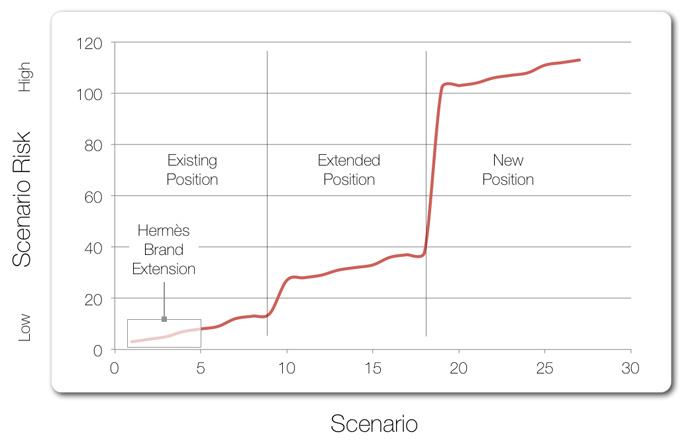BRAND VALUE STRATEGY
A Case-study in Success
Thierry Hermès in Paris, France founded the Hermès Company in 1837. Its first product was a horse bridle. Today (early 2012), its annual business is nearly 3 billion euros.
How did Hermès accomplish this remarkable feat?
They did it via brand extension, strictly following the strategy he had established in 1837.
What Hermès Did
Let’s look more carefully at Hermès – our favourite brand in terms of strategic discipline resulting in incredible success that results from unfailing adherence to strategic principles.
Immediately after its founding, Thierry Hermès established a strategy (whether he knew it or not) based on targeting noblemen using the simple but powerful position of MCCS:
- Highest quality MATERIALS
- Best-in-the-world CRAFTSMANSHIP
- Consistent CREATIVITY
- Superb timeless STYLE
From its first horse bridle, Hermès quickly became known for MCCS among Paris elites. Demand increased dramatically along with requests for other products.
While Hermès sought to expand, it did so in a manner that never compromised MCCS, nor did it ever lose sight of its target. By around 1880, the brand had extended “all the way” to saddles. Then a Hermès retail shop opened near Palais de l'Elysée, and geographic expansion extended into Russia and Asia.
In 1922, Hermès’ first handbag was introduced; in 1924, it first ventured into the United States; in 1929, its first collection of women’s apparel appeared. In the ‘30s came its now famous silk scarves, in ‘46 its silk ties, and in ‘49 its fragrances.
Today Hermès has over 50 product lines and about three billion euros in annual revenue. In 175, years the company has not deviated from its target except to extend it to include wealthy women, or from its MCCS position!
Hermès products today include:
Women’s Ready to Wear |
Fragrances |
Baby Gifts |
Women’s Scarves |
Bath and Shaving |
BABY GIFTS |
Women’s Silk Accessories |
Protective Travel Cases |
Tableware gift sets |
Women’s Stoles & Shawls |
Fragrance Gifts |
Porcelain & Earthenware |
Women’s Belts |
Herbal Essences |
Crystal |
Women’s Shoes |
Men’s shirts |
Cutlery |
Women’s Accessories |
Men’s active wear |
Ashtrays |
Bags and Luggage |
Men’s knitwear |
Candles |
Small Leather Goods |
Men’s under garments |
Change trays |
Agendas |
Men’s swim wear |
Scented drawer liners |
Notebooks |
Men’s TIES |
Leather photo frames |
Leather Accessories |
Men’s Belts |
Serving trays |
Silver Jewellery |
Men’s Shoes |
Beach Accessories |
Gold Jewellery |
Men’s Accessories |
Riding Accessories |
Enamel Jewellery |
Bed Linens |
Games |
Leather Jewellery |
Bath Linens |
Bicycle |
Horn & Lacquered Jewellery |
Blankets and Pillows |
|
Watches |
Furniture |
How They Did It
As mentioned in EXTENSION RISKS the most common extension methods may be some combination of approaches shown below:
Assigned Risk Values |
|||
Position |
Target |
Offer |
|
Existing |
x |
x |
x |
Extended |
x |
x |
x |
New |
x |
x |
x |
As previously covered, with each of the three methods (position, target, offer) having three approaches (existing, extended, new) there are 27 common ways for companies to extend brands, and each carries its own level of risk.
Of the 27 possible ways for Hermès to extend, they used only five:
Offer | Existing |
Conventional capacity expansion |
Offer | Extended |
For example into saddles |
Offer | New |
Handbags, women's apparel |
Target | Existing |
Conventional capacity expansion |
Target | Extended |
From wealthy men to include wealthy women |
What level of risk did Hermès face with these five means of extension?

Their extension approach has been extremely low risk and incredibly successful.
And that, in our view, is pretty smart!



